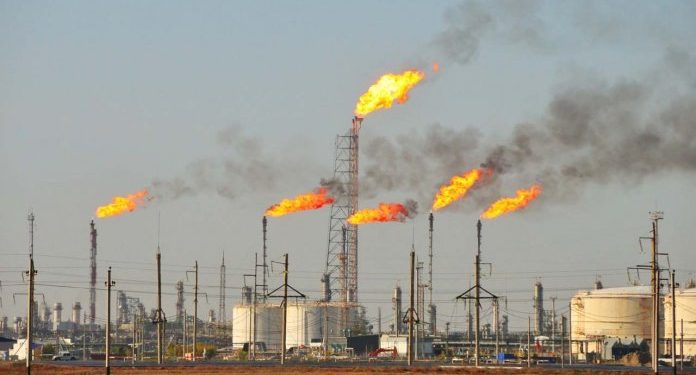To reduce what it described as incredible economic waste, compounded by environmental pollution, the Nigeria Sovereign Investment Authority (NSIA), plans to invest in the biggest gas flare capture in the country.The decision follows Nigeria’s high gas flaring rate reputed as the sixth highest, even as it hosts the ninth largest reserves estimated at 180 trillion cubic feet in the world.
Till date, previous efforts to end flaring in petroleum operations had proved abortive. Reports indicate that oil companies in Nigeria produce over 4 billion standard cubic feet (scf) of gas daily, of which about 700 million scf are wasted through flaring due to dearth of gas gathering infrastructure and lack of funding to invest in such ventures.
To this end, the Managing Director/Chief Executive Officer, NSIA, Uche Orji, told journalists at the weekend, in Lagos that the Authority is very advanced in concluding due process on a huge gas capture project. He said: “From my last count, there are more than 300 major gas flare sights in Nigeria. Those from Port Harcourt can share their experience, especially if you drive towards Bayelsa, Yenogoa, the night is lit with flare gas everywhere. This has been flaring for decades; forget about the pollution, that’s minor. The economic waste is incredible!
“The project we’re about to execute, we plan to announce it before the end of this year; we’re close to announcing it much earlier than that. It’s a project we’re working with other partners, I don’t want to disclose them at this stage, but we’re taking one of the largest onshore gas flare sight, and turning it into liquefied petroleum gas (LPG) capture. We will take out the non-gas liquids C1 and C2, and turn them to LPG, then take the C1, C2 and send them to power plants.
Recall that in 2016, the Federal Government, through the Ministry of Petroleum Resources, had initiated a market-based mechanism, National Gas Flare Commercialisation Programme, to eliminate gas flaring in the Niger Delta by 2020, ahead of global deadline of 2030, for zero-flaring being promoted by the World Bank.
However, the programme had not yielded the desired result, for which the NSIA is stepping in not only to boost the internal rate of return (IRR) by at least 19 per cent through the gas-LPG, and Gas-to-power programmes, but also earn carbon credits by selling carbon credit in Switzerland, that will shoot IRR up to above 25 per cent.
Orji noted that the NSIA intervention became imperative, seeing as, “the economic waste is mind-blowing… The ultimate reason we are looking at LPG is this; the biggest challenge we’re facing and part of the reasons we have conflicts, is climate change and deforestation. You see people they fell trees, burn them and sell the charcoal. Beyond the deforestation for charcoal export, are actually people cutting trees for plywood, which is why we want to boost LPG usage in Nigeria.”
With regard to other infrastructure investments, including the 3050-megawatt Mambilla Hydropower plant, Orji said the project, which has been in the pipeline for about two decades, was delayed for a number of reasons, until the Authority stepped in to institute a business model that will be executed under the Presidential Infrastructure Development Fund (PIDF). He said the NSIA will use external supervisors to authenticate what the Chinese contractors are doing, to minimise wastes. “The issue is, is Mambilla really 3,000Megawatts, do we have enough water to power that capacity or is it 2000MW or 1,500MW? S,o when they (Chinese) answer that question, we will invest, otherwise we will not invest.”
The Mambilla project is one of five projects worth about ?2.5 trillion being managed by the NSIA, under the PIDF, the others being the Lagos-Ibadan Expressway; Second Niger Bridge; Abuja-Kano Expressway; and the East West Road. NSIA Executive Director, Aminu Umar-Sadiq, also spoke about the social impact and economic benefits of other national programmes being managed by the Authority, such as the Presidential Fertiliser Initiative (PFI), which saw the delivery 10 million 50kg bags (500,000 metric tonnes) of NPK 20:10:10 fertilizer at a price of N5,500 in time for the wet season farming in 2017 and 2018.
He explained that given the importance of the agriculture sector to economic diversification efforts, the Fertilizer Initiative provides a financially sustainable alternative to the Growth Enhancement Support Program (GES), and is being managed by the NSIA in partnership with the Fertiliser Producers and Suppliers Association of Nigeria (FEPSAN), from procurement of inputs to the offtake of blended fertilizer.
Umar-Sadiq added that “While the 2017 PFI was largely funded by stop-gap funding from NSIA, the 2018 program is being funded through a combination of NSIA funding and the Central Bank of Nigeria’s (CBN) Real Sector Support Facility (RSSF).” With regard to the its return on investment and internal structure, NSIA Executive Director/Chief Operating Officer, Stell Ojekwe-Onyejeli, said the agency had performed creditably well, as underscored by its five-year financial performance from 2014 to 2018.
She said the Authority has been making profit year-on-year, with 2016 being its peak period, when it realised over N131.75 billion, buoyed by its foreign exchange revaluation gains. Notwithstanding that profit fell to a little over N45.18billion by 2018 end, the Authority is still doing well given the prevailing economic environment.
She noted that although the NSIA has a very large governance structure, comprising 56 members at the Council, nine in the Board, and six in Executive Management, the executives work independent of the Council and the Board, which act in advisory roles. Looking ahead, despite the global market volatility in the current year, the Authority promises to maintain its strategy of a diversified portfolio to drive returns and mitigate the negative impact.











